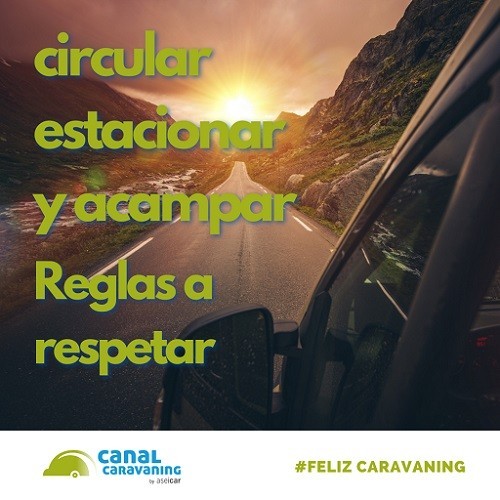DRIVING, PARKING AND CAMPING: RULES TO RESPECT
We are at a key moment for motorhoming in Spain. More and more people are discovering this form of travel and leisure that allows a degree of freedom, enjoyment and independence that is difficult to find in other forms of tourism.
More than 200,000 motorhomes and campers were registered in Europe in 2020. A very significant figure that shows the strength of a sector that is gaining more and more "followers" in the countries around us and in our own.
Now, more than ever, is the time for each and every one of us to take maximum responsibility:
- users, to respect the rules,
- to use our vehicle in a responsible manner,
- to park correctly only where it is allowed and where it does not harm anyone,
- and to camp only in campsites, authorised areas or motorhome service areas where camping is permitted.
It is also the responsibility of the professionals, sellers and renters of motorhomes and campers, to offer all the necessary information to the new customer on how to use the vehicle correctly, on what can and cannot be done.
The future of this sector and the image we project to society will depend on the correct behaviour of each and every one of us.
Many eyes are watching us. We have a lot at stake.
Although motorhomes and campers are synonymous with freedom, their use is regulated by Spanish legislation. Now that there are many new motorhomers in our country, it is important to clarify the 3 basic concepts that are essential to avoid problems, penalties and to be able to enjoy our passion with complete peace of mind.
THE 3 CONCEPTS: DRIVING, PARKING AND CAMPING
DRIVING
The General Road Traffic Regulations state that if you drive a vehicle with a gross vehicle weight of 3,500 kg or less (95% of motorhomes, campers and caravans), you do not need a special licence, the B1 is enough to drive properly. If our vehicle exceeds 3,500 kg of MMA, then it is necessary to have the C1, special for leisure vehicles.
As far as speed is concerned, motorhomes of less than 3,500 kg may drive, like cars, at a maximum of 120 km/h on motorways and dual carriageways and at 90 km/h on conventional roads. For vehicles over 3,500kg the limits change to 90km/h on motorways and dual carriageways and 80km/h on conventional roads.
On conventional roads with physical separation of the two directions of traffic, the road owner may set a maximum limit of 100 km/h for passenger cars and motor caravans with a maximum authorised mass of 3500 kg or less.

Camper driving
PARKING
Chapter VIII of the general road traffic regulations defines stopping and parking, articles 90 to 94. Motorhomes and campers, as M1 vehicles, like any passenger car, are subject to the same articles.
It is in the instruction 08/V-74 of the DGT, specifically at the end of article 3.1 where it is stated that: "...the fact that the occupants are inside the vehicle is not relevant, and the motorhome is no exception, it being sufficient that the activity carried out inside does not extend to the outside by means of the deployment of elements that overflow the perimeter of the vehicle such as tents, awnings, levelling devices, stabilising supports, etc.".
Therefore, motorhomes can PARK (WE ARE TALKING ABOUT PARKING), in authorised areas of urban or interurban public roads, in accordance with traffic and circulation regulations, under the same conditions as a car or any other vehicle of the same characteristics in terms of volume and weight; both day and night. However, it must always be borne in mind that:
-The road markings delimiting the pitch may not be exceeded.
-Only the perimeter of the vehicle itself must be respected, i.e. windows may not be opened, awnings may not be unfolded and camping equipment may not be taken out.
-The only contact with the ground must be through the wheels. Chocks are only allowed if the vehicle is parked on a slope.
-No liquids may be emitted or spilled outside.
Complying with these rules, more and more Autonomous Communities are establishing in their Decrees that the motorhome SHALL NOT BE CONSIDERED CAMPING, BUT STATIONED.
On the other hand, in Spain we already have more than 1,000 Motorhome Areas distributed throughout the country where you can park and spend the night comfortably; in addition to emptying, charging water tanks and / or charging batteries.
Other Autonomous Communities with older tourism decrees do not yet clarify these terms (parking and camping), but we hope that they will incorporate them in future updates of their tourism decrees and/or regulations, in order to avoid different interpretations and errors that generate confusion and problems.

Motorhomes parked

CAMPING
The only places allowed for camping are campsites and areas specifically designated for this purpose. There are also motorhome areas with facilities for emptying water, electrical connection and where camping is allowed, i.e. opening the windows of the vehicle, extending awnings and taking out tables and chairs.
Free camping, outside of these areas, is prohibited in our country.
MOTORHOME REGULATIONS
- - Instruction 08/V-74 DGT ON MOTORCARAVANES.
- - Motorhome Mobility Manual of the DGT.
- - Tourism Laws and Decrees on campsites and overnight stays/other documents of interest.









